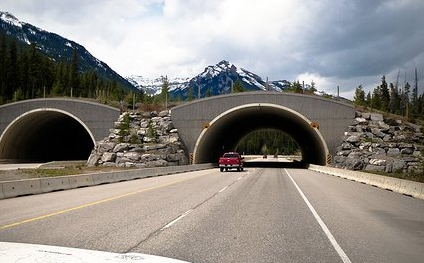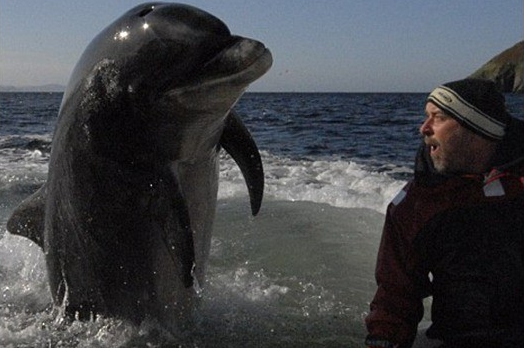HUMANS BANNED FROM USING BRIDGES
FOR ANIMALS IN GERMANY
When humans build roads, highways and canals, they set up unnatural barriers that divide animals in their own habitats. The consequences are more far-reaching than restricting the creatures’ mobility. In the long-term, not only does species diversity drop, but the limited mating prospects also inevitably decrease a species’ genetic diversity, meaning the animals live for shorter periods of time.
Last year, after a decade-long crusade, forester Gerhard Klesen finally secured the $6 million (US) necessary to build an animal bridge in Schermbeck, Germany. Klesen was inspired to construct the bridge after seeing the same idea thrive throughout the Netherlands.
Generally, creatures are wary of bridges of this ilk built near their habitat. As a result, few dare to cross them for the first year after construction. In the case of the Schermbeck bridge, however, the animals took to it immediately. After just three days, deer started utilizing the bridge, with boars doing the same by the end of the week. Scientists have since witnessed foxes, rabbits and bats travel over the bridge, as well.
The bridge doesn’t cater to just larger creatures, though. Smaller critters enjoy the structures, too. Bushes and grasses are planted to offer tiny animals both shelter and food. Some of the mice like the bridge’s dual-side access so much that they make their homes on the bridge on a permanent basis.
As tempting as it may seem, humans are banned from utilizing the bridge in order to keep animals feeling secure about crossing the structure. People caught defying this law will be fined nearly $50 (US).
Although, with just 35 in existence, animal bridges are fairly uncommon in Germany, the country is looking to change that in the near future. Over the next decade, Germany has allocated millions to add more than 100 more animal bridges in order to allow animals a safe method of traversing human-created obstacles.
Bearing in mind the steep cost, it’s a nice, environmentally friendly gesture to help animals live better and healthier lives. Here’s hoping that there are more efforts to protect animal habitats even in the face of human construction and expansion.
http://www.care2.com/causes/humans-banned-from-using-bridges-for-animals-in-germany.html
GERMANY SPENDS MILLIONS
ON ANIMAL - ONLY BRIDGES
Published: 18 Sep 2013 16:32 CET
Germany is living up to its environmentally-friendly image by spending millions of euros on building bridges just for animals. Humans caught crossing them face a €35 fine. More than a hundred wildlife bridges are to be built in the next decade.
Gerhard Klesen, a forester employed by the Ruhr Regional Association, spent a decade campaigning for an animal-only bridge to be built over a motorway in the town of Schermbeck in North Rhine-Westphalia.
Man-made barriers such as roads and canals restrict animals' natural movement, he said. That limits genetic diversity, which in turn leads to an increase in disease and shortened lifespans. The ‘Green Bridges’ are designed to counteract this effect.
"The area of land east of the motorway at Schermbeck is much smaller than that on the western side," Klesen told The Local. That's led to a decrease in species diversity on the eastern side, prompting Klesen to launch his ten-year campaign, which culminated in the opening of the "green bridge" - Germany's 35th - exactly a year ago.
But it was not always an easy sell. "Bridges cost a lot of money," Klesen said. However the determined forester persisted in his campaign, which got a financial boost from the Netherlands in 2005, where such bridges are relatively commonplace. "They're way ahead of us there," Klesen told The Local.
Both federal and EU funding followed and in September 2012, the €4.5 million, 2,700 square-metre bridge opened to animals.
"It usually takes a year before an animal dares to cross the green bridge," Klesen said. But the animals of Schermbeck are a plucky bunch. "One red stag traversed the bridge just three days after it was opened," Klesen said. Others followed suit and within a few days, boars were making the journey too.
Cameras set up along the bridge have captured a variety of creatures, including rabbits, foxes and bats, making their way across the specially-designed terrain.
"There are strips of sand just for insects, as well as grass, shrubs and other vegetation providing food and shelter to some of the smaller creatures," said Klesen.
Some animals, like mice, take to life in transit so much that they set up their permanent homes on the bridge. Others travel back and forth. Stags in particular often make the journey in search of a mate.
Although it will take decades to assess whether the bridge is managing to promote genetic diversity and health among bigger animals, the effects on smaller animals with shorter lifespan could be studied soon.
http://www.thelocal.de/national/20130918-51975.html


